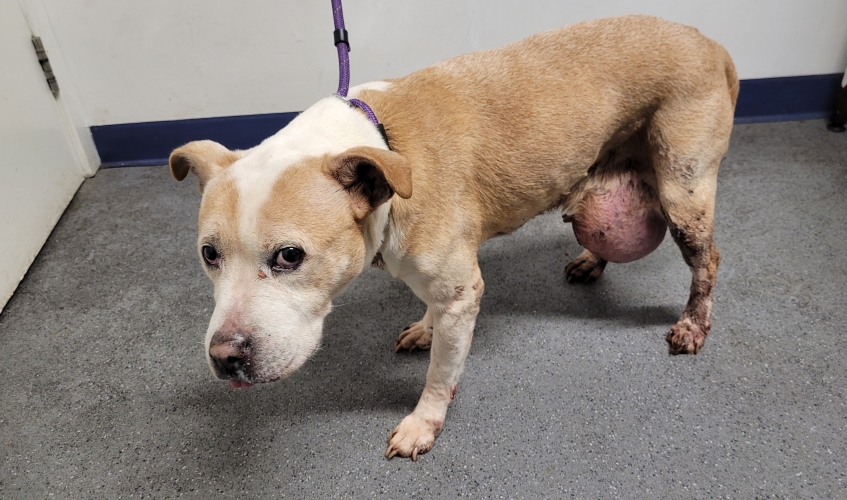What is the life expectancy of dog with cancer


According to studies, more than 45% of the dogs get cancer after the age of 10 years. Some types of cancer show up very fast in dogs. The most common types of dog cancer are melanomas and mast cell tumors. Which are types of skin cancers, lymphomas, and bone cancers. Cancer is the leading cause of dog death. Owning a dog has a positive effect on the mental health of the owner. Owning a dog reduces the sadness and increases the sense of purpose. Therefore, the death of the dog has a very strong impact on the mental health of its owner.
Common Types of Dog Cancer
There are many types of cancers, from skin diseases to organ failures. In this article, we are going to discuss the most common types of dog cancer that affect the life expectancy of a dog.
Osteosarcoma
Osteosarcoma is a bone tumor that usually develops in the limbs of the bones. It can also arise in the bones of the skull, spine, or in the ribcage. Moreover, there are also some cases reported of this tumor growing in mammary glands and muscles but these are rare.


The most common signs and symptoms of osteosarcoma are:
- swelling in the spine, legs
- pain
- lump on the dog’s body
- loss of appetite
The life expectancy of a dog suffering from Osteosarcoma is less than 5 months. Furthermore, the median age of this disease is 8 to 10 years.
Lymphoma
Dogs suffering from Lymphoma can only live up to 1-year maximum under medication. The most common symptoms of Lymphoma are:
- Weight Loss
- Increased thirst
- Increased urination
- Lethargy
- Fever
- swelling in the whole body, especially around the neck
Lymphoma in dogs is divided into four stages:
Stage one: A single lymph node arises
Stage two: At this stage, multiple nodes grew on one side of the diaphragm
Stage three: In the third stage, multiple nodes grow on both sides of the diaphragm
Stage four: In the fourth stage of Lymphoma, the liver or the spleen gets involved with any of the above stages.
This disease leads the dogs to death, and dogs die within a year. This is an uncurable disease and rare cases are available in which dogs have cured this disease. Golden Retriever, Beagle, Saint Bernard, and Rottweiler are more prone to suffer from this disease. In Lymphoma, the cancer gets to stage four and causes organ failure, which results in the ultimate death of the dog.
Hemangiosarcoma
The average time of survival of Hemangiosarcoma after the surgery is one to three months. It is a mesenchymal neoplasm originating from the endothelial cells of the blood vessels.
The most common signs of hemangiosarcoma are weakness, lethargy, lack of exercise, and loss of appetite.
Hemangiosarcoma is a aggressive cancer, that is not easy to detect. It is because, dogs don’t feel any pain, or show clear symptoms of this disease. Dogs suffering from this type of cancer only survive a couple of months and die.
Mammary gland tumors
It is the most common type of cancer in dogs. The mammary tumor is treated surgically, but there is no proper best procedure for this disease. It is very common among female dogs, and very rarely occurs in males.
See also: 10 signs your Border collie has cancer
A dog suffering from a mammary gland tumor gets ill and dies within a year. Early detection of the tumor could lead to long-term survival. If the malignant is detected on time, it can be removed via surgery, and the dog can live a longer life.


Some of the most common symptoms of mammary gland tumors are:
- New lump in the breast or underarm
- Thickening or swelling on the breast
- Irritation on breast skin
- Redness of skin in the nipple area
Factors Affecting the Life Expectancy of a Dog with Cancer
The first thing that matters the most in the life expectancy of a dog with cancer is the stage of that cancer. If the cancer is diagnosed early, then the dog will have more time to live. But, if it is diagnosed at the last stage, then surely, the dog will not have enough time to live.
Moreover, the treatment and its success rate also matter in the life expectancy of a dog with cancer. If the dog is having a better treatment, then it will have some extra time to spend. The life expectancy of dogs with cancer also varies from breed to breed. Some canine breeds are strong and live more with cancer than the other weak and less healthy breeds.
Additionally, the life expectancy also depends on the age of the dog. There are fewer chances for a dog to survive with cancer over the age of 10 years or less than 2 years. Adult dogs with cancer live up to more time than the older or younger ones.
Treatment Options for Dogs Suffering with Cancer
Some treatments could increase the life expectancy of dogs with cancer that cannot be cured properly. In some cases, the dogs have recovered from cancer, but it is very rare and also depends on the age of the dog.
Some of the most common treatments for Dogs with cancer are:
- Surgery
- Chemotherapy
- Radiation therapy
- Immunotherapy
- Palliative care
Conclusion:
The life expectancy of a dog with cancer varies on various factors that have been discussed above in detail. But, still, it is the responsibility of the dog owners to take their dogs to the vet once in every 6 months. In this way, any future disease or cancer symptoms can be detected on time, and possible treatment can be given.


